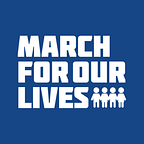The Trauma of a Generation on the National Stage
Congress now knows what it feels like to hide from a gun.
By Emma Rowland and Tatiana Washington
The most haunting images of the January 6th insurrection of the United States Capitol are images that capture the trauma of a generation: law enforcement standing behind a barricaded door with guns drawn at armed white supremacists and Congress Members comforting one another while sheltering behind a wall as rioters shot and damaged their way through the Capitol.
These are more than images to young people who have practiced or gone through active shooter drills and lockdowns. These acts of violence are our formative experiences.
Emma Rowland: As a co-author to this piece, I have been in a similar position when an armed robber hid on my school’s football field while being chased by police. At 14, I stood back against the wall, not knowing what was happening, terrified that he would burst in and start shooting.
Lawmakers have had the chance time and time again to show us that our lives are valuable and worth protecting. Instead, they’ve shrugged off school shootings as “the price we pay for the right to bear arms.” Is what happened at the Capitol also the price we must pay, Mitch McConnell?
Now you know what it feels like to hide from a gun in the place where you were supposed to be safe. Mitch McConnell, I hope that feeling of utter insecurity never leaves you because every young person in America knows exactly how you feel. I also hope that you have learned your lesson when it comes to passing legislation that would prevent school shootings. We have come to you on several occasions to demand that you do exactly that. You could have prevented the deaths of schoolchildren across the country. But because you do not have a spine, you decided not to. The price you have to pay for the right to bear arms is their blood on your hands.
One image will forever be missing from the history books that tell the story of the January 6th insurrection — the image of the white supremacists being arrested for their treasonous actions. Instead, they will show the police officers who literally waved the rioters into the Capitol. Federal agencies knew of the credible threats that these extremists were making, but no reinforcements were sent for the protection of our Democracy. That is a stark contrast to the way police and local governments over-prepare for violence when Black, Indigenous and People of Color (BIPOC) are peacefully demonstrating against injustice. THAT is the definition of white privilege.
Tatiana Washington: This past year, I was on the frontlines in Wisconsin with so many other Black people and allies protesting against state-sanctioned violence and police brutality. We were arrested, tear-gassed, shot with rubber bullets, and more. Police violence and gun violence have always been personal for me. I lost my Aunt Sherida in a murder-suicide at the hands of her husband, a Milwaukee police officer, and my hometown has made national headlines several times in the last few years for police shooting and killing Black Wisconsinites.
Just this week, Wisconsin Governor Tony Evers called in the National Guard ahead of the District Attorney’s decision on whether Kenosha Officer Ruston Shesky would be charged for shooting Jacob Blake seven times in the back, leaving him paralyzed. The verdict hadn’t even been announced yet, but the possibility that Black people would protest the failure of the justice system was treated as a threat of violence that required troops on the ground.
A former Wauwatosa police officer, Joseph Mensah has shot and killed three men of color — Alvin Cole, Antonio Gonzales and Jay Anderson. His only punishment was being put on paid leave until he quit. Tracy Cole, Alvin Cole’s mother was pulled from her car and assaulted by officers in Wauwatosa during a protest. She was nonviolent, unarmed and identified herself to officers, and also informed them of her medical condition, but she was brutalized and demeaned before being sent to the hospital for her injuries.
In DC, BIPOC protestors have continuously been met with excessive force from National Park Police, Capitol Police, and MPD.
Where were these agencies this week?
I keep seeing people say that this week’s events are un-American. But is it really? Was the 2012 Oak Creek gurdwara shooting un-American? How about the Mother Emmanuel AME shooting? The Tree of Life shooting? The Waffle House shooting in Antioch, Tennessee? Was Charlottesville un-American?
I can’t help but think of the irony of white supremacists calling the Capitol building, which was built by enslaved Africans, “The People’s House” — an institution where laws are created that continue to cause harm to BIPOC communities — was being destroyed by white supremacists. We need to accept America’s history of anti-Blackness, violence, and white supremacy in order to dismantle it.
Emma Rowland (left), 20, is a Policy Associate at March For Our Lives and a sophomore at American University in Washington, DC majoring in Data Science. She is from Scottsdale, Arizona.
Tatiana Washington (right), 20, is a Policy Associate at March For Our Lives and is also the Executive Director of 50 Miles More, a Black youth-led collective that fights for racial justice through Black feminism.
